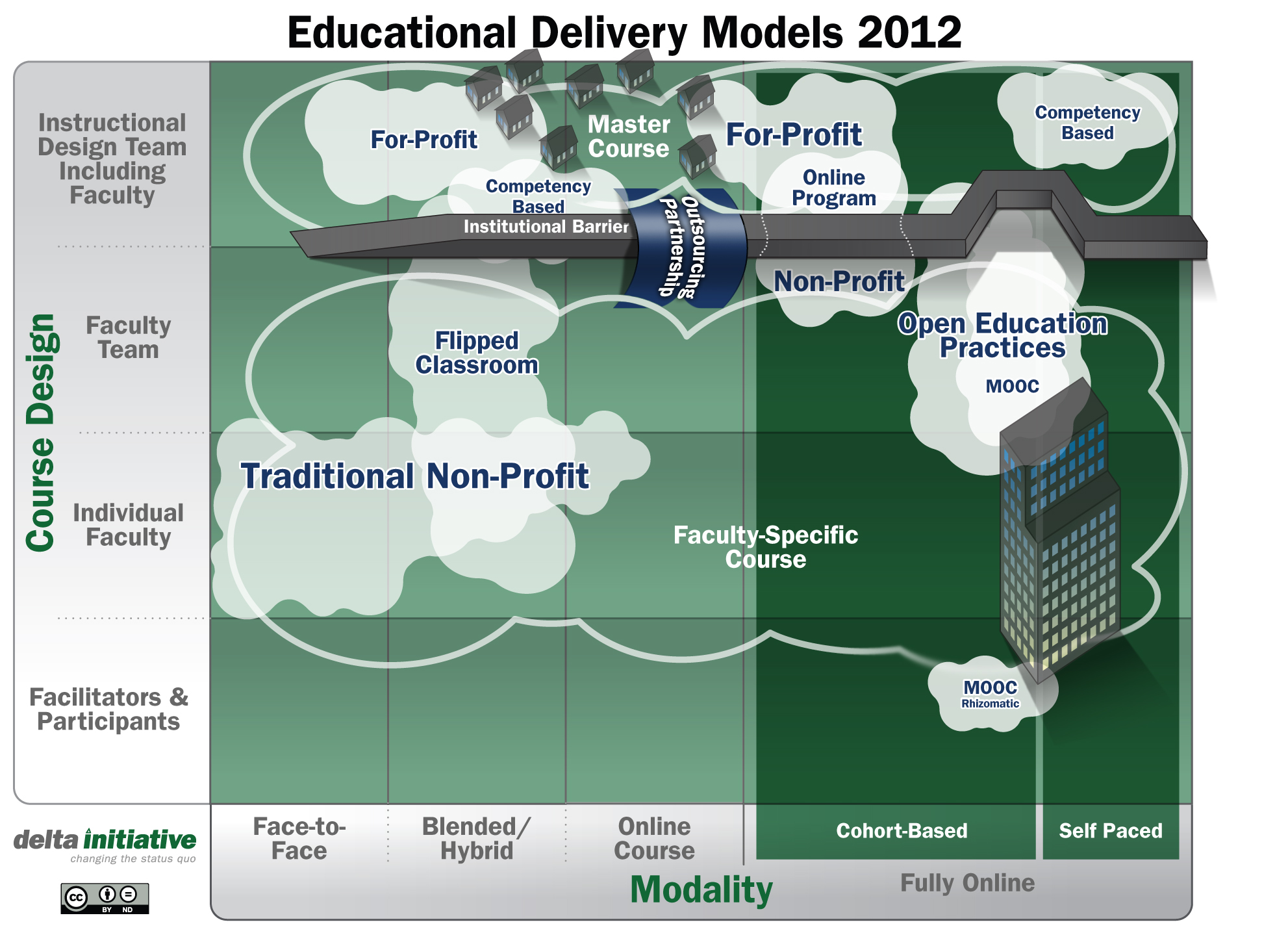In part 1 of this series, I described a new landscape of educational delivery models. In part 2 I described the master course concept and how it presents a cultural barrier that most traditional institutions cannot cross, at least without a dedicated online organization or an outsourced partnership.
Why does it matter that we describe these educational delivery models with finer granularity than just traditional and online? Because the aims of the models differ, as do the primary methods of how these models are created and delivered.
With all of the recent interest in Massive Open Online Courses (MOOCs), it would be worth summarizing the two branches of MOOCs including recent posts or interviews by the founders of the concept.
Scale and Access
In most online programs, at least those with more than few thousand students, the delivery method of this scale is the duplication of course sections in the manner of tract housing (for a better description, see part 2). But are there other methods to achieve scale (and therefore access) without duplicating sections? MOOCs represent an alternate approach where the actual course itself provides scale, allowing essentially unlimited enrollment in the single course section in the manner of a large apartment building.
History of Both Branches in the Words of the Founders
Clark Quinn posted a nice summary of the two different branches of MOOCs.
The Stanford model, as I understand it (and I haven’t taken one), features a rigorous curriculum of content and assessments, in technical fields like AI and programming. The goal is to ensure a high quality learning experience to anyone with sufficient technical ability and access to the Internet. Currently, the experience does support a discussion board, but otherwise the experience is, effectively, solo.
The connectivist MOOCs, on the other hand, are highly social. The learning comes from content presented by a lecturer, and then dialog via social media, where the contributions of the participants are shared. Assessment comes from participation and reflection, without explicit contextualized practice.
MOOCs were first implemented in 2007 / 2008. The early history is described quite nicely in the following posts, all by the founders of Rhizomatic MOOC concept (also called Distributed, Proto or Connectivist).
- March 5 “MOOCs for the win!” – George Siemens starts by describing the two branches of MOOCs and summarizes much of the recent conversation online. He then gives his views on where we are and how MOOCs are still an experiment.
- April 8 “A review of rhizomatic learning in Mendeley” – Dave Cormier, while not directly discussing MOOCs, describes his perspective on rhizomatic learning.
- April 23 “The Rise of MOOCs” – Stephen Downes shares his answers to an interview that gives some of the key background on the 2008 “watershed” moment of Siemens / Downes’ CCK08 course. Stephen also describes the creation of the Stanford branch of MOOCs as well as sharing his personal objective in pursuing MOOCs.
- April 24 “Wishing I Understood” – David Wiley, whose web site tag line is “pragmatism over zeal”, questions some of Stephen’s objectives and wonders if he understands this correctly. David then shares his thoughts on experts and empowerment.
- April 25 “Proto-MOOCs Rock!” – Jim Groom calls attention to a well-written article by Steve Kolowich, and then calls out Steve’s article and summarizes his thoughts.
The most press recently, however, has been based on the Stanford branch of MOOCs, started with the Artificial Intelligence course in 2011.
- March 5 “Instruction for Masses Knocks Down Campus Walls” – Tamar Lewin of the NY Times writes the most influential article so far, concentrating on Stanford’s early efforts, and the Sebastian Thrun move to found Udacity based on his experience.
- March 20 “The Stanford Education Experiment Could Change Higher Learning Forever” – Steven Leckart of Wired interviews both Sebastian Thrun and Peter Norvig and gives a good background of the Stanford branch and its influences.
Future of MOOCs
To understand the future of MOOCs, I think it’s important to consider these two observations.
- The two current branches of MOOCs are different and will not merge – despite the common name, they have different aims and methods. It is a mistake, in my opinion, to overlook the differences.
- Both branches are early prototypes or pilots. The future of MOOCs will be based on further developing the concepts and techniques – we should not expect massive adoption until future generations of MOOCs evolve. As George stated:
It is important to realize that MOOCs are not (yet) an answer to any particular problem. They are an open and ongoing experiment. They are an attempt to play with models of teaching and learning that are in synch with the spirit of the internet. As with any research project, it is unlikely that they will be adopted wholesale in traditional universities. Most likely, bits and pieces will be adopted into different teaching models.
The quick emergence of the MOOC concept is quite significant for educational technology. In less than 5 years, and entirely new approach to provide cost-effective scale and access has emerged, and the next generation or two of MOOCs could lead to significant new options in higher education. In my opinion, the critical piece for MOOCs to be “an answer to [a] particular problem” is either badges or accreditation acceptance.
Update: Fixed link to Clark Quinn’s piece

[…] – e-Literate – MOOCs: Two Different Approaches to Scale, Access and Experimentation […]